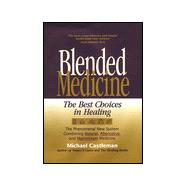Blended Medicine profiles 21 mainstream and alternative therapies, including nutrition, naturopathy and biofeedback, explaining each in detail and describing what it is most successfully used to treat. An A to Z reference of 106 health conditions describes and prioritizes each ailment's most effective therapies. Blended Medicine introduces a new world of medicine where mainstream doctors and alternative practitioners provide effective and enlightened health care to every individual.








